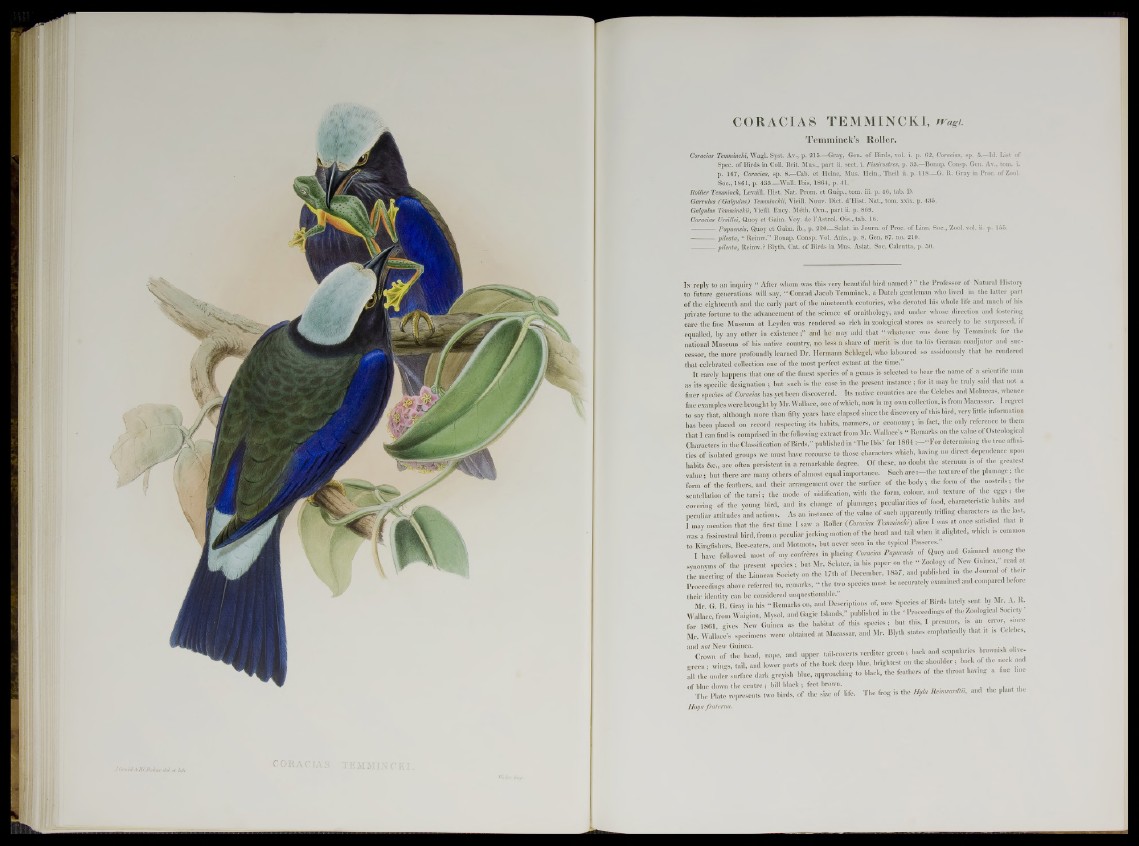
'.lâ/ ácllCIiukUr. del/ e t lith ■
CORACIAS TEMMINCKI, WaSi.
Tem m in ck ’s Roller.
Coradas Temtnincki, W agl. Syst. Av., p. 215.—Gray, Gen. of Birds, vol. i. p. 62, Coradas, sp. 5.—Id. List of
Spec, of Birds in Coll. Brit. Mus., p art ii. sect. i. Fisdrostres, p. 33.—Bonap. Consp. Gen. Av., tom. i.
p. 167, Coradas, sp. 8.—Cab. et Heine, Mus. Hein., Theil ii. p. 118.—G. R. Gray in Proc. of Zool.
Soc., 1861, p. 433 Wall. Ibis, 1864, p, 41.
Rollier Temminck, Levaill. Hist. Nat. Prom, et Guep., tom. iii. p. 46, tab. D.
Garruhis ( Gaigitlus) Temminckii, Vieill. Nouv. Diet. d’Hist. Nat., tom. xxix. p. 435.
Galgulus Temminckii, Vieill. Ency. Méth. Ora., p a rt ii. p. 869.
Coracias Urvillei, Quoy et Gaim. Voy. de l’Astrol. Ois., tab. 16.
----------- Papuensis, Quoy et Gaim. ib., p. 220 Sclat. in Journ. of Proc. of Linn. Soc., Zool. vol. ii. p. 155.
----------- pileata, “ Reinw.” Bonap. Consp. Vol. Anis., p. 8. Gen. 87. no. 210.
----------- pileata, Reinw.? Blyth, Cat. of Birds in Mus. Asiat. Soc. Calcutta, p. 50.
In reply to an inquiry “ After whom was this very beautiful bird named ? ” the Professor of Natural History
to future generations will say, “ Conrad Jacob Temminck, a Dutch gentleman who lived in the latter part
of the eighteenth and the early part of the nineteenth centuries, who devoted his whole life and much of his
private fortune to the advancement of the science of ornithology, and under whose direction and fostering
care the fine Museum at Leyden was rendered so rich in zoological stores as scarcely to be surpassed, if
equalled, by any other in existence;” and he may add that “ whatever was done by Temminck for the
national Museum of his native country, no less a share of merit is due to his German coadjutor and successor,
the more profoundly learned Dr. Hermann Schlegel, who laboured so assiduously that he rendered
that celebrated collection one of the most perfect extant at the time.’
It rarely happens that one of the finest species of a genus is selected to hear the name of a scientific man
as its specific designation ; but such is the case in the present instance ; for it may be truly said that not a
finer species of Coracias has yet been discovered. Its native countries are the Celebes and Moluccas, whence
fine examples were brought by Mr. Wallace, one of which, now in my own collection, is from Macassar. I regret
to say that, although more than fifty years have elapsed since the discovery of this bird, very little informaUon
has been placed on record respecting its habits, manners, or economy ; in fact, the only reference to them
that I can find is comprised in the following extract from Mr. Wallace’s “ Remarks on the value of Osteological
Characters in the Classification of Birds,” published in ‘The Ibis’ for 1864 "For determining the true affinities
of isolated groups we must have recourse to those characters which, having no direct dependence upon
habits &c., are often persistent in a remarkable degree. Of these, no doubt the sternum is of the greatest
value ; but there are many others of almost equal importance. Such are the texture of the plumage ; the
form of the feathers, and their arrangement over the surface of the body ; the form of the nostrils ; the
scutellation of the tarsi ; the mode of nidification, with the form, colour, and texture of the eggs; the
covering of the young bird, and its change of plumage; peculiarities of food, characteristic habits and
peculiar attitudes and actions. As an instance of the value of such apparently trifling characters as the last,
I may mention that the first time I saw a Roller (.Coracias Temminc/ei) alive I was at once satisfied that it
was a fissirostral bird, from a peculiar jerking motion of the bead and tail when it alighted, which is common
to Kingfishers, Bee-eaters, and Motmots, but never seen in the typical Passeres.”
1 have followed most of my confrères in placing Coracias Papuensis of Quoy and Gaimard among the
synonyms of the present species ; but Mr. Sclater, in his paper on the “ Zoology of New Guinea,’ read at
the meeting of the Linnean Society on the 17th of December, 1857, and published ,n the Journal of their
Proceedings above referred to, remarks, “ the two species must be accurately examined and compared before
their identity can be considered unquestionable.” H h H
Mr G R Gray in his I Remarks on, and Descriptions of, new Species of Birds lately sent by Mr. A. i
Wallace from Waigiou, Mysol, andGagie Islands,” published in the • Proceedings of the Zoological Society
for 1861, gives New Guinea as the habitat of this species; but tbis, I presume is an error, since
Mr. Wallace’s specimens were obtained at Macassar, and Mr. Blyth states emphatically that it is Celebes,
and not New Guinea. I , . . M W
Crown of the head, nape, and upper tail-coverts verditer green ; back and scapular,es brownish olive-
green • wings tail, and lower parts of the back deep blue, brightest on the shoulder ; back of the neck and
all the’ under surface dark greyish blue, approaching to black, the feathers of the throat having a fine line
of bine down the centre ; bill black ; feet brown.
The Plate represents two birds, of the size of life. The frog is the Hyla Bemmrdta, and the plant the
Hoya fraterna.